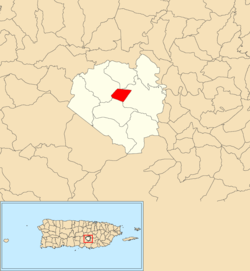Aibonito barrio-pueblo
Aibonito barrio-pueblo is a barrio and the administrative center (seat) of Aibonito, a municipality of Puerto Rico. Its population in 2010 was 3,539.[2][3][4]
Aibonito barrio-pueblo Barrio Pueblo Aibonito | |
|---|---|
Municipality Seat | |
 Casa Alcaldía de Aibonito | |
 Location of Aibonito barrio-pueblo within the municipality of Aibonito shown in red | |
 Aibonito barrio-pueblo Location of Puerto Rico | |
| Coordinates: 18°08′11″N 66°15′51″W[1] | |
| Commonwealth | |
| Municipality | |
| Area | |
| • Total | 0.8 sq mi (2 km2) |
| • Land | 0.8 sq mi (2 km2) |
| • Water | 0.0 sq mi (0 km2) |
| Population (2010) | |
| • Total | 3,539 |
| • Density | 4,423.8/sq mi (1,708.0/km2) |
| Source: 2010 Census | |
| Time zone | UTC−4 (AST) |
As was customary in Spain, in Puerto Rico, the municipality has a barrio called pueblo which contains a central plaza, the municipal buildings (city hall), and a Catholic church. Fiestas patronales (patron saint festivals) are held in the central plaza every year.[5][6]
The central plaza history

The central plaza, or square, is a place for official and unofficial recreational events and a place where people can gather and socialize from dusk to dawn. The Laws of the Indies, Spanish law, which regulated life in Puerto Rico in the early 19th century, stated the plaza's purpose was for "the parties" (celebrations, festivities) (Spanish: a propósito para las fiestas), and that the square should be proportionally large enough for the number of neighbors (Spanish: grandeza proporcionada al número de vecinos). These Spanish regulations also stated that the streets nearby should be comfortable portals for passersby, protecting them from the elements: sun and rain.[5]
Sectors
Barrios (which are like minor civil divisions)[7] in turn are further subdivided into smaller local populated place areas/units called sectores (sectors in English). The types of sectores may vary, from normally sector to urbanización to reparto to barriada to residencial, among others.[8][9][10]
The following sectors are in Aibonito barrio-pueblo:[11]
Barrio Pueblo Norte, Barrio Pueblo Sur, and Urbanización Buena Vista.
Urban development
When law 1-2001 was passed,[12] measures were taken to identify and address the high levels of poverty and lack of resources and opportunities affecting specific communities in Puerto Rico. By 2008, there were 742 places on the list of Comunidades Especiales de Puerto Rico and in 2004 the municipal area of Aibonito had made the list.[13][14][15][13]
Then in 2014, William Alicea Pérez, the mayor of Aibonito celebrated the improvements that had been made to Aibonito, specifically to its urban center. Several infrastructure projects were completed in 2014. An assisted living center was inaugurated, and a stadium as well. The mayor announced plans for a future gym, gave updates on progress of another stadium and other projects that were under way for the benefit of Aibonito. Pérez indicated that its urban center had been transformed and would continue to be improved upon. The construction of a gym for boxing and martial arts is underway with the help of Miguel Cotto, a Puerto Rican boxing champion.[16]
References
- "US Gazetteer 2019". US Census. US Government.
- Picó, Rafael; Buitrago de Santiago, Zayda; Berrios, Hector H. (1969). Nueva geografía de Puerto Rico: física, económica, y social, por Rafael Picó. Con la colaboración de Zayda Buitrago de Santiago y Héctor H. Berrios. San Juan Editorial Universitaria, Universidad de Puerto Rico,1969.
- Gwillim Law (20 May 2015). Administrative Subdivisions of Countries: A Comprehensive World Reference, 1900 through 1998. McFarland. p. 300. ISBN 978-1-4766-0447-3. Retrieved 25 December 2018.
- Puerto Rico:2010:population and housing unit counts.pdf (PDF). U.S. Dept. of Commerce, Economics and Statistics Administration, U.S. Census Bureau. 2010.
- Santullano, Luis A. (10 March 2019). Mirada al Caribe. 54. Colegio de Mexico. pp. 75–78. doi:10.2307/j.ctvbcd2vs.12. JSTOR j.ctvbcd2vs.12.
- Pariser, Harry S. (2003). Explore Puerto Rico, Fifth Edition. San Francisco: Manatee Press. pp. 52–55. Retrieved 10 February 2019.
- "US Census Barrio-Pueblo definition". factfinder.com. US Census. Archived from the original on 13 May 2017. Retrieved 5 January 2019.
- "Agencia: Oficina del Coordinador General para el Financiamiento Socioeconómico y la Autogestión (Proposed 2016 Budget)". Puerto Rico Budgets (in Spanish). Retrieved 28 June 2019.
- Rivera Quintero, Marcia (2014), El vuelo de la esperanza: Proyecto de las Comunidades Especiales Puerto Rico, 1997-2004 (first ed.), San Juan, Puerto Rico Fundación Sila M. Calderón, ISBN 978-0-9820806-1-0
- "Leyes del 2001". Lex Juris Puerto Rico (in Spanish). Retrieved 24 June 2020.
- "PRECINTO ELECTORAL AIBONITO 069" (PDF). Comisión Estatal de Elecciones (in Spanish). PR Government. 21 September 2019. Retrieved 2 July 2019.
- "Leyes del 2001". Lex Juris Puerto Rico (in Spanish). Retrieved 24 June 2019.
- "Comunidades Especiales de Puerto Rico" (in Spanish). 8 August 2011. Retrieved 24 June 2019.
- "Evoluciona el proyecto de Comunidades Especiales". El Nuevo Dia (in Spanish). 24 February 2017. Retrieved 24 June 2019.
- ElVocero.com, Por. "Ya es ley Oficina para el Desarrollo Socioeconómico y Comunitario". El Vocero de Puerto Rico (in Spanish). Retrieved 24 June 2019.
- "Rinde cuentas el Alcalde de Aibonito". La Cordillera. Retrieved 24 June 2019.